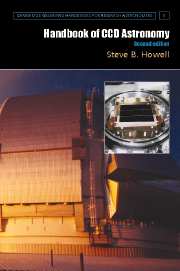Book contents
- Frontmatter
- Contents
- Preface to the first edition
- Preface to the second edition
- 1 Introduction
- 2 CCD manufacturing and operation
- 3 Characterization of charge-coupled devices
- 4 CCD imaging
- 5 Photometry and astrometry
- 6 Spectroscopy with CCDs
- 7 CCDs used in space and at short wavelengths
- Appendices
- References
- Index
2 - CCD manufacturing and operation
Published online by Cambridge University Press: 05 June 2012
- Frontmatter
- Contents
- Preface to the first edition
- Preface to the second edition
- 1 Introduction
- 2 CCD manufacturing and operation
- 3 Characterization of charge-coupled devices
- 4 CCD imaging
- 5 Photometry and astrometry
- 6 Spectroscopy with CCDs
- 7 CCDs used in space and at short wavelengths
- Appendices
- References
- Index
Summary
Before we begin our discussion of the physical and intrinsic characteristics of charge-coupled devices (Chapter 3), we want to spend a brief moment looking into how CCDs are manufactured and some of the basic, important properties of their electrical operation.
The method of storage and information retrieval within a CCD is dependent on the containment and manipulation of electrons (negative charge) and holes (positive charge) produced within the device when exposed to light. The produced photoelectrons are stored in the depletion region of a metal insulator semiconductor (MIS) capacitor, and CCD arrays simply consist of many of these capacitors placed in close proximity. Voltages, which are static during collection, are manipulated during readout in such as way as to cause the stored charges to flow from one capacitor to another, providing the reason for the name of these devices. These charge packets, one for each pixel, are passed through readout electronics that detect and measure each charge in a serial fashion. An estimate of the numerical value of each packet is sent to the next step in this process, which takes the input analog signal and assigns a digital number to be output and stored in computer memory.
Thus, originally designed as a memory storage device, CCDs have swept the market as replacements for video tubes of all kinds owing to their many advantages in weight, power consumption, noise characteristics, linearity, spectral response, and others.
- Type
- Chapter
- Information
- Handbook of CCD Astronomy , pp. 8 - 35Publisher: Cambridge University PressPrint publication year: 2006



